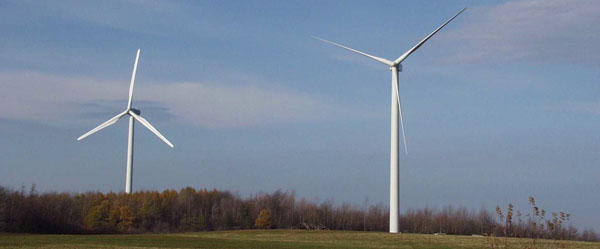 |
By Valerie Lapinski, Colin Orcutt, Maureen Sullivan, Nicole Turso, and Brian Winkowski
New York: The New Windy City?
City officials on Thursday honored Chelsea Piers, the country’s biggest sports and entertainment complex, for converting to 100% wind power. Chelsea Piers made the switch in October, making it the biggest business in NYC to use wind energy – equal to taking 2800 cars off of the road, or offsetting the generation of 13,600 tons of green house gas emissions.
But although Chelsea Piers is perched on the breezy west side of the city, the windmill in front of the building is merely decorative. Instead of spending money in attempt to harness wind itself, the facility buys wind credits, which act as a pre-order on wind power being generated somewhere else.
“This is energy that has no supply line around the world, it’s generated here at home. It has no emissions, no climate change impact, and once the investment is made it has no fuel costs,” said Jorge J. Lopez, CEO of ConEdison Solutions at Thursday’s event.
NYC Honors Chelsea Piers for Wind Power
|
Do-It-Yourself Wind Power Some people don’t want to wait through this process–from wind farm to energy supplier–to get their energy, but still want to harness the power of the wind. Energy2Green touts the idea that wind and solar power systems can be built right at home. Gotwind.org also has a step-by-step guide on how to build your own wind turbine. It turns out the city isn’t opposed to a little DIY engineering – last summer Mayor Michael Bloomberg voiced support of windpower on skyscrapers, a sentiment consistent with his 25-year sustainability initiative, PlaNYC. This recent piece in the New York Times profiles several buildings in the city that operate at least partially on windpower from installed turbines. |
How Wind Credit Works
Wind power is the second most successful renewable source of energy after hydroelectric, or water-fueled turbines that create energy.
Companies like Chelsea Piers buy wind power credits from energy suppliers, including ConEdison Solutions, Accent Energy and Energetix, who buy power from wind farms located throughout the United States. Since some days are windier than others, it’s the suppliers’ job to make sure that their clients are getting the amount of power they’re paying for.
Jorge J. Lopez, CEO of ConEdison Solutions, explains wind credit:
These farms send wind-generated power to the electricity grid that is then verified by an independent audit system and directed to homes and businesses. Customers can choose whether they will receive wind power, standard power, or a combination of the two. Here’s a handy graphic from the BBC that illustrates how wind energy gets to the power grid.
Wind power, however, does come at a premium cost—about two and a half more cents per kilowatt. In addition, customers can choose which wind they will receive—either nationally produced or regional, though regionally produced wind power is more expensive.
As for Chelsea Piers, facility directors think the environmental benefit is worth the extra investment.
“We were surprised to learn that the incremental cost of purchasing 100 percent green power was actually quite small,” Chairman Roland W. Betts said in a press statment. “We believe it will pay for itself in a few years.”

Recent Comments